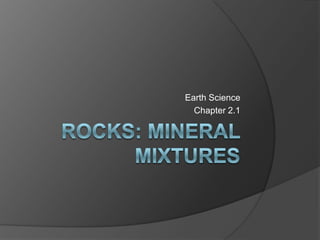Earth Science 2.1 : The Rock Cycle
•Als PPTX, PDF herunterladen•
9 gefällt mir•20,751 views
Melden
Teilen
Melden
Teilen

Empfohlen
Weitere ähnliche Inhalte
Was ist angesagt?
Was ist angesagt? (20)
Ähnlich wie Earth Science 2.1 : The Rock Cycle
Ähnlich wie Earth Science 2.1 : The Rock Cycle (20)
Mehr von Chris Foltz
Mehr von Chris Foltz (20)
Kürzlich hochgeladen
Mehran University Newsletter is a Quarterly Publication from Public Relations OfficeMehran University Newsletter Vol-X, Issue-I, 2024

Mehran University Newsletter Vol-X, Issue-I, 2024Mehran University of Engineering & Technology, Jamshoro
Kürzlich hochgeladen (20)
Micro-Scholarship, What it is, How can it help me.pdf

Micro-Scholarship, What it is, How can it help me.pdf
UGC NET Paper 1 Mathematical Reasoning & Aptitude.pdf

UGC NET Paper 1 Mathematical Reasoning & Aptitude.pdf
Kodo Millet PPT made by Ghanshyam bairwa college of Agriculture kumher bhara...

Kodo Millet PPT made by Ghanshyam bairwa college of Agriculture kumher bhara...
Basic Civil Engineering first year Notes- Chapter 4 Building.pptx

Basic Civil Engineering first year Notes- Chapter 4 Building.pptx
On National Teacher Day, meet the 2024-25 Kenan Fellows

On National Teacher Day, meet the 2024-25 Kenan Fellows
Unit-IV; Professional Sales Representative (PSR).pptx

Unit-IV; Professional Sales Representative (PSR).pptx
Asian American Pacific Islander Month DDSD 2024.pptx

Asian American Pacific Islander Month DDSD 2024.pptx
General Principles of Intellectual Property: Concepts of Intellectual Proper...

General Principles of Intellectual Property: Concepts of Intellectual Proper...
Earth Science 2.1 : The Rock Cycle
- 1. Rocks: mineral mixtures Earth Science Chapter 2.1
- 2. Objectives: Describetwo ways rocks have been used by humans. Describefour processes that shape Earth’s features. Describe how each type of rock changes into another type as it moves through the rock cycle. List two characteristics of rock that are used to help classify it.
- 3. The Rock Cycle Rock naturally occurring solid mixture of one or more minerals or organic matter New rock forms from old rock material constantly Rock cycle The series of processes in which a rock forms, changes from one type to another, is destroyed, and forms again by geological processes
- 5. The Value of Rock Important natural resource for as long as humans have existed Ancient and modern civilizations used granite, limestone, marble, sandstone, slate and other rocks as construction materials Important ingredient in concrete and plaster, both of which are commonly used in construction Capitol Building Pyramids and Sphinx, Giza, Egypt
- 6. TajMahal, India Granite Countertops Brooklyn Bridge Stonehenge
- 7. Processes that Shape the Earth Certain geological processes make and destroy rock These processes Shape the features of our planet Influence the type of rock that is found in certain areas Grand Canyon, Arizona Hawaiian Islands
- 8. Weathering, Erosion, and Deposition Weathering Process in which water, wind, ice, and heat break down rock Important because it breaks down rock into fragments of which sedimentary rock is made
- 9. Erosion Process by which wind, water, ice, or gravity transports soil and sediment from one location to another Ice Wind Water
- 10. Deposition Process in which sediment moved by erosion is dropped and comes to rest
- 11. Heat and Pressure Sedimentary rock can also form when buried sediment is squeezed by the weight of overlaying layers of sediment If the temperature and pressure are high enough, the rock can change into metamorphic rock If the rock gets hot enough to melt, this creates the magma that eventually cools to form igneous rock
- 12. How the Cycle Continues Buried rock is exposed at the Earth’s surface by a combination of uplift and erosion Uplift Movement within the Earth that causes rocks inside the Earth to be moved to the surface When uplifted rock reaches the Earth’s surface, weathering, erosion, and deposition begin
- 13. Rock Cycle illustrated and erosion
- 14. Rock Classification Three main classes Igneous rock Sedimentary rock Metamorphic rock Each class of rock can be divided further, based on differences in the ways rocks form granite obsidian shale sandstone slate marble
- 15. Igneous rock can be divided again based on whether the magma from which it forms cools on the Earth’s surfaceor below ground Sedimentary and metamorphic rocks are also divided into smaller groups Scientists study rocks in detail using two important criteria: Composition Texture
- 16. Composition Chemical makeup of a rock Can describe either the minerals or other materials in the rock Texture Quality of a rock that is based on the sizes, shapes, and positions of the rock’s grains 95% calcite limestone 5% aragonite siltstone sandstone Conglomerate Fine-grained medium-grained Coarse-grained